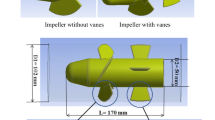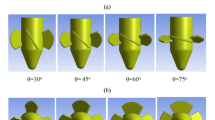Abstract
The interplay of impeller and stator is investigated for an axial-flow pump. Three stator vane numbers of 5, 7 and 9 are devised to match the same impeller. The renormalization group k-e turbulence model is used to simulate three-dimensional flows in three pumps with different vane numbers. Axial velocity distributions at impeller outlet and stator outlet are comparatively analyzed. Experiments assess operation performance of the three pumps. Vibration parameters and static pressure fluctuations are measured as well. It is indicated that the influence of vane number on both pump head and pump efficiency is insignificant. Large stator vane number contributes to the improvement of the uniformity of axial velocity distribution at impeller outlet. At stator outlet, similar tendency is revealed. Severe vibration occurs near the outlet bend of the pump, as is particularly remarkable at vane number of 9. For the three cases, blade passing frequency and its harmonics are predominant in the frequency spectra of pressure fluctuations. As flow rate increases from 0.8Q to 1.0Q, high-frequency pressure fluctuations are suppressed considerably at vane number of 9, while the other two cases also manifest a decline in overall pressure fluctuation amplitude. The 7-vane case is the most preferable one among the three cases in terms of both pump performance and pressure fluctuation between the impeller and the stator.
Similar content being viewed by others
References
E. Egusquiza, C. Valero, X. Huang, E. Jou, A. Guardo and C. Rodriguez, Failure investigation of a large pump-turbine runner, Engineering Failure Analysis, 23 (2012) 27–34.
M. Vahdati, A. I. Satma and M. Imregun, An integrated nonlinear approach for turbomachinery forced response prediction, Part II: case studies, J. of Fluid and Structures, 14 (2000) 103–125.
D. Zhang, W. Shi, T. Li, H. Zhang and X. Guan, Property of unsteady pressure and meridional velocity in wake region of axial-flow pump impeller, Transactions of the Chinese Society of Agricultural Engineering, 28 (17) (2012) 32–37.
P. Wei, H. Chen and W. Lu, Characteristics of force acting on adjustable axial flow pump blade, Frontiers of Energy Power Engineering in China, 2 (4) (2008) 508–513.
D. Kaya, Experimental study on regaining the tangential velocity energy of axial flow pump, Energy Conversion and Management, 44 (2003) 1817–1829.
J. F. Gülich, Centrifugal pumps, Second Ed., Springer, Berlin Heidelberg, Germany (2010).
X. J. Yu and B. Liu, Stereoscopic PIV measurement of unsteady flows in an axial compressor stage, Experimental Thermal and Fluid Science, 31 (2007) 1049–1060.
N. Courtiade, X. Ottavy and N. Gourdain, Modal decomposition for the analysis of the rotor-stator interactions in multistage compressors, J. of Thermal Science, 21 (3) (2012) 276–285.
H. Wang and H. Tsukamoto, Fundamental analysis on rotorstator interaction in a diffuser pump by vortex method, J. of Fluids Engineering, 123 (2001) 737–747.
E. Göttlich, J. Woisetschläger, P. Pieringer, B. Hampel and F. Heitmeir, Investigation of vortex shedding and wakewake interaction in a transonic turbine stage using laser- Doppler-velocimetry and particle-image-velocimetry, J. of Turbomachinery, 128 (1) (2006) 178–187.
Y. Wu, S. Liu, H. Yuan and J. Shao, PIV measurement on internal instantaneous flows of a centrifugal pump, Science China Technological Science, 54 (2011) 270–276.
D. Zhang, W. Shi, B. Chen and X. Guan, Unsteady flow analysis and experimental investigation of axial flow pump, J. of Hydrodynamics (Ser. B), 22 (1) (2010) 35–43.
S. Kim, K.-Y. Lee, J.-H. Kim, J.-H. Kim, U.-H. Jung and Y.-S. Choi, High performance hydraulic design techniques of mixed-flow pump impeller and diffuser, Journal of Mechanical Science and Technology, 29 (1) (2015) 227–240.
C. Kang, Q. Huang and Y. Li, Influence of vane number on the performance of axial-flow pump under low-flow-rate conditions, Proc. of ASME FEDSM 2013, Nevada, USA (2013) Doi:10.1115/FEDSM2013-16331.
Z. Qian and Y. Wang, Numerical simulation of water flow in an axial flow pump with adjustable guide vanes, JMST, 24 (4) (2010) 971–976.
V. Yakhot and S. A. Orszag, Renormalization group analysis of turbulence, J. of Scientific Computing, 1 (1986) 3–51.
Y. Wu, S. Liu, H.-S. Dou, S. Wu and T.n Chen, Numerical prediction and similarity study of pressure fluctuation in a prototype Kaplan turbine and the model turbine, Computers & Fluids, 56 (2012) 128–142.
ANSYS CFX-Solver Theory Guide, ANSYS Inc. (2009).
H. Huang, H. Gao and Z. Du, Numerical simulation andexperimental study on flow field in an axial flow pump, J. of Shanghai Jiaotong University, 43 (1) (2009) 124–128.
H. Bing, S. Cao, C. He and L. Lu, Experimental study of the effect of blade tip clearance and blade angle error on the performance of mixed-flow pump, Science China Technological Science, 56 (2013) 293–298.
Y. Zheng, F. Zhang, X. Jiang and J. Zhang, Research on outlet pressure pulsation of reverse operation in tubular pump model experiment, Fluid Machinery, 35 (1) (2007) 1–7.
Z. Li, M. Yang, N. Zhang and B. Gao, Experimental study on vibration characteristics of axial-flow pump under different operating conditions, J. of Engineering Thermophysics, 34 (5) (2013) 866–869.
F. Shi and H. Tsukamoto, Numerical study of pressure fluctuation caused by impeller-diffuser interaction in a diffuser pump stage, J. of Fluids Engineering, 123 (9) (2001) 466–474.
C. Chen, A. Yang, G. Li, P. Zhou and Q. Wang, Fluid excitation forces of axial flow pumps with different number of blades, Noise and Vibration Control, 33 (3) (2013) 55–59.
Z. Li, M. Yang, B. Gao and C. Kang, Experimental study on vibration characteristics induced by cavitation of axialflow pump, J. of Engineering Thermophysics, 33 (11) (2012) 1887–1891.
Author information
Authors and Affiliations
Corresponding author
Additional information
Recommended by Associate Editor Donghyun You
Can Kang received his Ph.D. from the Jiangsu University of China. He is an associate professor and Ph.D. supervisor at the Jiangsu University of China. His research interests include optimal design of impeller pumps, non-intrusive flow measurement, high-pressure water jet and cavitation in aerated flows.
Rights and permissions
About this article
Cite this article
Kang, C., Yu, X., Gong, W. et al. Influence of stator vane number on performance of the axial-flow pump. J Mech Sci Technol 29, 2025–2034 (2015). https://doi.org/10.1007/s12206-015-0423-4
Received:
Revised:
Accepted:
Published:
Issue Date:
DOI: https://doi.org/10.1007/s12206-015-0423-4




